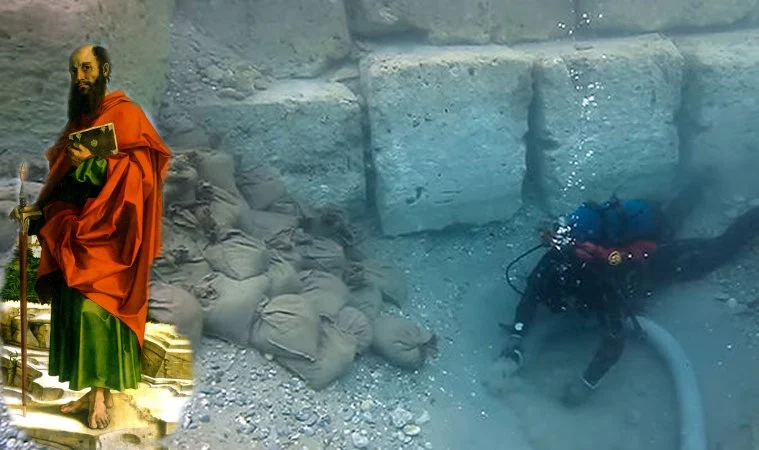Archaeologists have discovered the ruins of the flooded harbor of Lechaon, the ancient Greek city of Corinth.
The city of Corinth was one of the most prosperous and strong cities for nearly a millennium, from the sixth century BC to the sixth century AD. It was built next to the Isthmus of Corinth, connecting the Peloponnese Peninsula and the rest of Greece. The city controlled all overland movements along the isthmus and the sea ones – along the Corinthian canal. According to ancient sources, marine trade brought most of Corinth’s income.
Scientists have explored the ancient harbor Lechaon, owned by Corinth, for several years. Before starting a full-scale excavation, the researchers conducted geophysical surveys of the underwater ruins of the harbor. Until now, archaeologists have discovered several malls built of stone blocks, a breakwater, supposedly built of well-preserved wooden caissons and an entrance to a canal leading to the inner harbor. In 2015, scientists decided to focus on the study of two objects: the caissons and the entrance to the canal, made of stone blocks.
The pier, built of six wooden caissons, 57 meters long, is a unique design, first found in Greece. The caissons were barges that loaded and flooded. According to the results of preliminary radiocarbon analysis, archaeologists dated the coffer mole of the 5th century. Around the same time, the Basilica of St. Leonid was built in Lechaon, the largest Christian temple of that time. Perhaps the pier was built at one time with the basilica so that the harbor could withstand a large stream of ships with pilgrims. Whatever it was, both the harbor and the basilica were destroyed during the earthquake that occurred in the late 6th or early 7th centuries.
The remains of the entrance to the canal leading to the inner harbor of Lechaon were visible on the shore even before the excavations began, so its location was understandable. But the scale of the design was much more than archaeologists had expected. So far, scientists have discovered about 55 meters on both sides of the canal. They also found that the harbor, apparently, was located further towards the sea, about 45 meters from the modern coastline. In the future, researchers plan to conduct geophysical studies of the object.
According to one of the excavation leaders, Björn Leuven, the aim of the research is to understand how the harbor was built and developed in different epochs: the Ancient Greek, Roman and Byzantine periods of the existence of Corinth.
The city of Corinth was one of the most prosperous and strong cities for nearly a millennium, from the sixth century BC to the sixth century AD. It was built next to the Isthmus of Corinth, connecting the Peloponnese Peninsula and the rest of Greece. The city controlled all overland movements along the isthmus and the sea ones – along the Corinthian canal. According to ancient sources, marine trade brought most of Corinth’s income.
Scientists have explored the ancient harbor Lechaon, owned by Corinth, for several years. Before starting a full-scale excavation, the researchers conducted geophysical surveys of the underwater ruins of the harbor. Until now, archaeologists have discovered several malls built of stone blocks, a breakwater, supposedly built of well-preserved wooden caissons and an entrance to a canal leading to the inner harbor. In 2015, scientists decided to focus on the study of two objects: the caissons and the entrance to the canal, made of stone blocks.
The pier, built of six wooden caissons, 57 meters long, is a unique design, first found in Greece. The caissons were barges that loaded and flooded. According to the results of preliminary radiocarbon analysis, archaeologists dated the coffer mole of the 5th century. Around the same time, the Basilica of St. Leonid was built in Lechaon, the largest Christian temple of that time. Perhaps the pier was built at one time with the basilica so that the harbor could withstand a large stream of ships with pilgrims. Whatever it was, both the harbor and the basilica were destroyed during the earthquake that occurred in the late 6th or early 7th centuries.
The remains of the entrance to the canal leading to the inner harbor of Lechaon were visible on the shore even before the excavations began, so its location was understandable. But the scale of the design was much more than archaeologists had expected. So far, scientists have discovered about 55 meters on both sides of the canal. They also found that the harbor, apparently, was located further towards the sea, about 45 meters from the modern coastline. In the future, researchers plan to conduct geophysical studies of the object.
According to one of the excavation leaders, Björn Leuven, the aim of the research is to understand how the harbor was built and developed in different epochs: the Ancient Greek, Roman and Byzantine periods of the existence of Corinth.
Tags
Histori
